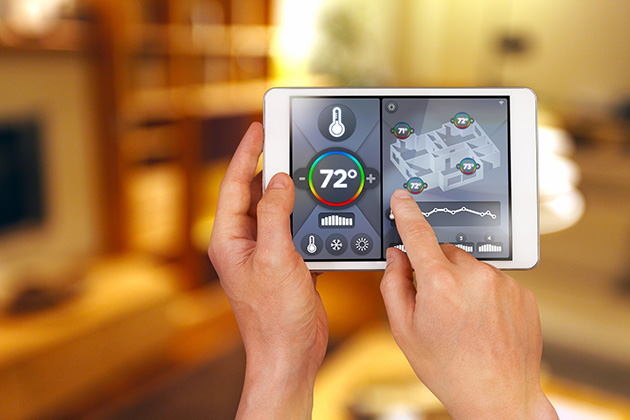The air we breathe every day has a significant impact on our health and comfort. However, as time goes by, the air quality in our environment is decreasing. Air pollution not only occurs outdoors, but also inside our own homes. Fortunately, smart home technology is here as a solution to manage indoor air quality more effectively and efficiently.
In this article, we will discuss various smart home solutions that can help you manage indoor air quality. We will explore the latest technology, practical tips, and long-term benefits of implementing a smart home system to improve air quality. Let’s start the journey towards cleaner air and healthier living in your home.

Smart Home Technology to Monitor Air Quality
One of the first steps in managing indoor air quality is to monitor it accurately. Smart home technology offers a variety of sophisticated devices that can help you do this easily and efficiently. Smart air quality sensors are one of the main innovations in this category.
Smart air quality sensors can detect a variety of pollutants and air parameters, such as fine particulate matter (PM2.5 and PM10), CO2 (carbon dioxide), CO (carbon monoxide), volatile organic compounds (VOCs), as well as temperature and humidity. These devices are usually connected to your home Wi-Fi network, allowing you to monitor air quality in real-time via a smartphone app or online dashboard.
Some smart air quality sensors even come with an automatic alert feature. This feature will notify you if certain pollutant levels exceed safe thresholds, so you can take immediate action to improve the situation. With this accurate and timely information, you can make better decisions about how to improve the air quality in your home.
Smart Ventilation Systems
Good ventilation is key to maintaining indoor air quality. Smart ventilation systems take this concept to the next level by automating and optimizing the airflow in your home. This technology works by adjusting window openings, controlling fans, and managing your HVAC (Heating, Ventilation, and Air Conditioning) system based on air quality data collected by the sensors.
Smart ventilation systems can adjust their operation based on a variety of factors, such as outdoor air quality, temperature, humidity, and indoor pollutant levels. For example, if the sensor detects elevated CO2 levels in your home, the system can automatically increase the flow of fresh air from outside to reduce CO2 concentrations.
Additionally, many smart ventilation systems come with machine learning features. This feature allows the system to learn your usage patterns and preferences over time, so it can optimize ventilation settings for maximum comfort and energy efficiency.
Smart Air Purifiers
Air purifiers have long been used to improve indoor air quality. However, with the advent of smart home technology, air purifiers have become more sophisticated and effective. Smart air purifiers combine traditional air-cleaning capabilities with smart control and connectivity, creating a more comprehensive solution for managing indoor air quality.
Smart air purifiers typically come with multiple types of filters, including HEPA filters to capture fine particles, activated carbon filters to absorb odors and harmful gases, and even UV filters to kill microorganisms. What sets smart air purifiers apart is their ability to automatically adapt to the air conditions around them.
With built-in air quality sensors, smart air purifiers can detect changes in air quality and adjust their operation accordingly. For example, if the sensor detects increased levels of dust or allergens, the air purifier can automatically increase its fan speed to clean the air faster.
Synergy with Smart Home Technologies
One of the key advantages of smart home solutions for managing air quality is their ability to integrate with broader smart home systems. This integration allows the various devices and systems in your home to work together harmoniously to create an optimal indoor environment.
For example, an air quality sensor can communicate with your smart HVAC system. If pollutant levels increase, the HVAC system can automatically turn on air circulation mode or increase filtration. Similarly, if the sensor detects high humidity, the system can activate a dehumidifier to prevent mold and germ growth.
Integration also allows for centralized control via a smartphone app or voice assistant like Amazon Alexa or Google Assistant. This way, you can easily monitor and manage air quality throughout your home from one convenient interface.
Enduring Benefits of Air Quality Control
Investing in smart home solutions to manage air quality can provide significant long-term benefits. Primarily, improved air quality leads to enhanced health. By reducing your exposure to indoor air pollutants, you can lower your risk of a variety of health problems, including allergies, asthma, and other respiratory illnesses. Additionally, good air quality can improve sleep quality and productivity. Clean, fresh air can help you sleep better and wake up feeling more refreshed.
It can also help improve concentration and performance during work or study hours. From a financial perspective, effective air quality management can save you money in the long run. By reducing your risk of air quality-related health problems, you can save on healthcare costs. Additionally, integrated smart home systems can help optimize energy usage, which in turn can lower your utility bills.
Closing
Adopting smart home solutions for managing indoor air quality is not just a trend, but a necessary step towards healthier living. With the ability to monitor pollutants, optimize ventilation, and purify air effectively, these technologies empower homeowners to take control of their environment. Investing in such systems enhances overall well-being and contributes to a sustainable future.
Ultimately, the long-term benefits of improved air quality extend beyond health. Cleaner air fosters productivity and enhances the quality of life for all occupants. By integrating smart technologies into our homes, we create a harmonious living space that prioritizes comfort and safety, ensuring a healthier environment for generations to come.